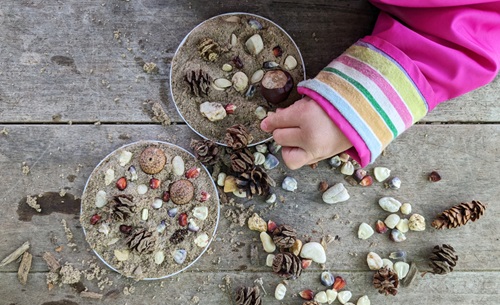Nurturing children's biophilia
Developmentally appropriate environmental education for young children
| June 2012Extensive research in children’s development and experience in early childhood education has shown that young children:
- Have unique learning styles that match their stages of development, which occur in an orderly sequence during their lives. All domains of development – physical, emotional, social, language and cognitive – change in a predictable way.
- Form their values in their earliest years.
The way children learn is completely different than adults. To be effective, children’s environmental education needs to be designed to match children’s developmental needs, interests, abilities and learning styles. Young children are active learners. Their best learning occurs with hands-on, interactive play and discovery rather than on trying to impart knowledge. Young children have a natural curiosity that requires direct sensory experience rather than conceptual generalisation. To be effective and engage children based upon their developmental abilities and ways of learning, their hands-on sensory experiences need to be immersive and open-ended rather than structured and scripted. When it comes to environmental education, the best learning environments are informal and naturalistic outdoor nature-scapes where children have unmediated opportunities for adventure and self-initiated play, exploration and discovery.
“Childhood has its own way of seeing, thinking and feeling and nothing is more foolish than to try to substitute ours for theirs.”
Children experience the natural environment differently than adults. Adults usually see nature as background for what they are doing, as a visual aesthetic experience. Children experience nature not as background for events, but rather as a stimulator and experiential component of their activities. They look for its affordances, what it affords them to do. Children judge nature not by its aesthetics, but rather by the nature of their interactions with it.
Children have an innate biological tendency to bond with the natural world known as biophilia. For children’s natural inclination of biophilia to develop they must be given developmentally appropriate opportunities to learn about the natural world based on sound principles of child development and learning.
If children’s natural attraction to nature is not given opportunities to be flourish during their early years, biophobia, an aversion to nature may develop. Biophobia ranges from discomfort in natural places to contempt for whatever is not man-made, managed or air-conditioned. Biophobia is also manifest in regarding nature as nothing more than a disposable resource.
John Burroughs cautioned that, “Knowledge without love will not stick. But if love comes first, knowledge is sure to follow.” The problem with most environmental education programs is that they try to impart knowledge and responsibility before children have been allowed to develop a loving relationship with the natural world. Children’s emotional and affective values of nature develop earlier than their abstract, logical and rational perspectives. We need to allow children to develop their biophilia, their love for the Earth, before we ask them to academically learn about it and become guardians of it.
A problem with most young children’s environmental education programs is that they approach education from an adult’s, rather than a child’s perspective. One of the main problems is premature abstraction, teaching children too abstractly. Children do not even begin to develop the ability for abstract reasoning until starting at age nine. One result of trying to teach to children at too early of an age about abstract concepts like rainforest destruction, acid rain, ozone holes and whale hunting can be dissociation. When we ask children to deal with problems beyond their cognitive abilities, understanding and control, they can become anxious, tune out and develop a phobia to the issues. In the case of environmental issues, biophobia – a fear of the natural world and ecological problems – a fear of just being outside – can develop. Studying about the loss of rain forests and endangered species may be perfectly appropriate starting in middle school, but is developmentally inappropriate for younger children.
Children’s experiences during early childhood should nurture the conception of the child as a part of nature. It is during early childhood when children’s experiences give form to the values, attitudes, and basic orientation toward the world that they will carry with them throughout their lives. Regular positive interactions within nature allow children to feel comfortable in it, develop empathy with it and grow to love it. No one can love what he or she doesn’t know through intimate association. Not only are regular developmentally appropriate experiences in nature important, but also adults, both parents and teachers, need to model enjoyment of, comfort with and respect for nature.
Research is substantiating that an empathy with and love of nature, along with positive environmental behaviours and attitudes, grow out of children’s regular contact with and play in the natural world. Recent research strongly suggests that the opportunity for children younger than age 11 to explore in wild, natural environments is especially important for developing their biophilic tendencies and that the type of play should be child-nature play, such as catching frogs in a creek or fireflies at night, versus only child-child play such as playing war games with walnuts. Such informal exploration stimulates genuine interest in and valuing of environmental knowledge that is then provided in more structured environmental education programs. There are three basic stages for children’s development of environmental values and their environmental education:
- Early childhood (ages 3/4 to 7)
- Early/middle grade school (ages 7 to 11)
- Adolescence (ages 12 to 17)
Early childhood – empathy
During early childhood, the main objective of environmental education should be the development of empathy between the child and the natural world. In addition to opportunities to explore and play in nature, one of the best ways to foster empathy with young children is to cultivate relationships to animals. This includes exposure to indigenous animals, both real and imagined.
Young children are implicitly drawn to animals and especially baby animals. Animals are an endless source of wonder for children, fostering a caring attitude and sense of responsibility towards living things. Children interact instinctively and naturally with animals, talk to them, and invest in them emotionally. A little-known fact about children and animals is that studies of the dreams of children younger than age 6 reveal that as many as 90% of their dreams are about animals.
Endangered species are not appropriate at this age. Rather, the common, everyday species that fill children’s yards, neighbourhoods and communities are the developmentally appropriate choice, as children can relate to them. Moreover, with these age children, the environmentally correct notion of not anthropomorphising animals doesn’t apply.
Children’s exposure to relationships with animals needs to be cultivated with live animal contact and animal-based stories, songs and other experiences. Developing an emotional connectiveness – empathy – to the natural world is the essential foundation for the later stages of environmental education.
One of the best examples of developmentally appropriate early childhood environmental education are the “outdoors-in-all-weather nursery schools” and “forest kindergartens.” Since the 1990s, parents and educators in Germany have established 700 Waldkindergärtens where children ages 3 to 6 spend their entire day in the outdoors in all but the most extreme weather. Forest kindergartens are now found in many other countries including Scotland, Scandinavia, Switzerland and Austria.
The closest equivalent in the United States are nature center-based preschools, such as The Nature Preschool at the Schlitz Audubon Nature Center near Milwaukee, Wisconsin, where the curriculum includes daily outdoor nature discovery in the nature center’s 185 acres of diverse habitat.
Early/middle grade school – exploration
Exploring the nearby world and learning your place in it should be the primary objective for this ‘bonding with the earth stage’ of environmental education. This includes opportunities to explore and experience the surrounding wild and semi-wild natural world found in children’s neighbourhoods and communities. Developmentally appropriate activities include creating small imaginary worlds, hunting and gathering, searching for treasures, following streams and pathways, exploring the landscape (natural, not adult manicured landscapes), taking care of animals and gardening. Plants have substantial interest to children when they provide wildlife habitat.
Adolescence – social action
Social action appropriately begins around age 12 and extends beyond age 17. As children start to discover the ‘self’ of adolescence and feel their connectiveness to society, they are naturally inclined toward wanting to save the world, assuming of course that they had the opportunities in their earlier years to develop empathy for and to explore the natural world. Their opportunities for environmental preservation should be focused at the local level where children can relate to the outcomes rather than in some far-off unknown rain forest.
The world once offered children the thousands of delights of the natural world. Children used to have free access to the outside world of wild nature, whether in the vacant lots and parks of urban areas or the fields, forests, streams of suburbia and rural areas. Children could explore and interact with the natural world with little or no restrictions or supervision.
The lives of children today are much more structured, supervised and scheduled with few opportunities to explore and interact with the natural outdoor environment. Children’s physical boundaries have shrunk. Childhood and regular unsupervised play in the outdoor natural world are no longer synonymous. Today, most children live what one play authority has referred to as a childhood of imprisonment. Children are disconnected from the natural world outside their doors.
Early childhood and grade schools have the opportunity to help fill the void in children’s lives of regular access to the natural world. With developmentally appropriate natural outdoor environments and programs, schools can help our children develop to become responsible stewards of the earth.
To accomplish this, children need regular contract with natural environments that offer them opportunities for play and exploration, where they can explore and bond with nature, rather than the paradigm of recess on manufactured play equipment in a sterile or manicured landscape area. Rather than playgrounds, children need to be offered naturalised environments, the wilder the better, where they can interact with nature and the animals and insects that inhabit it. Children need to be given daily access to outdoor natural environments for extended periods of time.
Schools, early childhood educators and teachers need to free themselves from the paradigm of giving children indoor play and learning and manufactured outdoor playgrounds and instead allow children to reclaim the magic that is their birthright – the ability to play and learn outdoors through exploration, discovery and the power of their imaginations in intimate contact with nature. It is only through such positive experiences in outdoor nature that children will develop their love of nature and a desire to protect it for their future and late generations.
“There’s no way that we can help children to learn to love and preserve this planet if we don’t give them direct experiences with the miracles and blessings of nature.”
© 2008 White Hutchinson Leisure & Learning Group
References
Bergen, D. 1988. Play as a medium for learning and development. Portsmouth, NH: Heinemann.
Berk,L., & A. Winsler. 1995. Scaffolding children’s learning: Vygotsky and early childhood education. Washington, D.C., NAEYC.
Bixler, Robert D., Floyd, Myron E. & Hammutt, William E. (2002). Environmental Socialization: Qualitative Tests of the Childhood Play Hypothesis, Environment and Behaviour, 34(6), 795-818
Bredencamp, S., &C. Copple. 1997. Developmentally appropriate practice in early childhood education. Washington, D.C., NAEYC: 10-20.
Bunting, T.E. & L.R. Cousins (1985) Environmental dispositions among school-age children. Environment and Behaviour, 17(6)
Case, R. &Y. Okamotr. 1996. The role of central conceptual structures in the development of children’s thought. Monographs of the Society of Research in Child Development, vol. 61, no 2, serial no. 246. Chicago:University of Chicago Press.
Chawla, L. (2006). Learning to love the natural world enough to protect it. Barn, 2, 57-78
Chawla, L. (2007). Childhood Experiences Associated with Care for the Natural World: A Theoretical Framework for Empirical Results, Children, Youth and Environments 17(4), 144-170
Chipeniuk, Raymond C. (1994). Naturalness in Landscape: An Inquiry from a Planning Perspective (PhD dissertation), University of Waterloo, Ontario.
Dutcher, D. D., Finley, J. C., Luloff, A. E. & Johnson, J. B. (2007). Connectivity With Nature as a Measure of Environmental Values, Environment and Behaviour, (39)4, 474-493
Dyson, A.H., & C. Genishi. 1993. Visions of children as language users: Language and language education in early childhood. Handbook of research on the education of young children, ed. B. Spodek, 122-36. New York: Macmillan.
Erikson, E. 1963, Childhood and society: New York: Norton.
Fein, G. (1981). Pretend play: An integrative review. Child Development 52, 1095-118.
Francis, Mark (interview) au Kathryn Devereaux (1991). Children of Nature, U. C. Davis Magazine, 9(2)
Fromberg, D. 1992. Play. The early childhood curriculum: A review of current research, 2d ed. C. Seefeldt, 35-74. New York: Teachers College Press.
Gallahue, D. 1993. Motor development and movement skills acquisition in early childhood education. Handbook of research on the education of young children, B. Spodek (ed), 24-41. New York: Macmillan.
Gibson, J. J. 1977. The theory of affordances., Perceiving, acting, and knowing: Toward an ecological Psychology, R. Shaw & J. Bransford,67-82. Hillsdale, NJ: Erlbaum (eds).
Hart, Roger.1997. Children’s Participation: The theory and practice of involving young citizens in community development and environmental care, Earthscan Publications Limited, UK.
Hinds, J. & Sparks, P. (2008). Engaging with the natural environment: The role of affective connection and identity, Journal of Environmental Psychology, 28(2) 109-120
Joy. A. Palmer & Jennifer Suggate with Barbara Bajd, Paul Hart, Roger K. P. Ho, J. K. W. Ofwono-Orecho, Marjorie Peries, Ian Robottom, Elissavet Tsaliki & Christie Van Staden (1998). An Overview of Significant Influences and Formative Experiences on the Development of Adults' Environmental Awareness in Nine Countries. Environmental Education Research 4(4), 445-464
Kals, E., Schumacher, D., & Montada, L. (1999). Emotional affinity towards nature as a motivational basis to protect nature. Environment & Behaviour, 31(2), 178-202
Kals, Elisabeth & Ittner, Heidi. 2003. Children’s Environmental Identity, Indicators and Behavioral Impacts, Identity and the Natural Environment, The Psychological Significance of Nature, Clayton, Susan and Opotow, Susan (eds). The MIT Press, Cambridge, Massachusetts.
Kellert, S. 1997. Kinship to Mastery, Biophilia in Human Evolution and Development. Island Press, Washington, D.C.
Kellert, Stephen R. 2002. Experiencing Nature: Affective, Cognitive, and Evaluative Development, Children and Nature: Psychological, Sociocultural, and Evolutionary Investigations. Cambridge, MA: The MIT Press.
Moore, R. & Wong, H. 1997. Natural Learning: Rediscovering Nature’s Way of Teaching. Berkeley, CA MIG Communications.
Moore, R. C. & Marcus, C. C. 2008. Healthy Planet, Healthy Children: Designing Nature into the Daily Spaces for Childhood. Biophilic design: the theory, science, and practice of bringing buildings to life. Kellert, S. R., Heerwagen, J., & Mador, M. (eds). Hoboken, NJ, Wiley 153-203
Olds, Anita, Children Come First Video, 2001 produced by Community Playthings
Piaget, J. 1952. The origins of intelligence in children. New York: International Universities Press.
Plye, Robert M., 2002. Eden in the Vacant Lot: Special Places, Species and Kids in the Neighborhood of Life. Children and Nature: Psychological, Sociocultural, and Evolutionary Investigations, Kahn, Jr. Peter & Kellert, Stephen (eds). Cambridge, MA: The MIT Press.
Rivkin, Mary S. 1990. The Great Outdoors: Restoring Children’s Rights to Play Outside. National Association for the Education of Young Children, Washington, D.C.
Schultz, P. Wesley, Shriver, Chris, Tabanico, Jennifer J. & Khazian, Azar M. (2004). Implicit connections with nature. Journal of Environmental Psychology, 24(1), 31-42
Smilansky, S., & L. Shefatya. 1990. Facilitating play: A medium for promoting cognitive, socioemotional and academic development in young children. Gaithersburg, M.D: Psychosocial & Educational Publications.
Sobel, David. 1996. Beyond Ecophobia: Reclaiming the Heart of Nature Education, Great Barrington, MA: The Orion Society.
Sobel, David. 2004. Place-Based Education, Connecting Classrooms & Communities, Great Barrington, MA: The Orion Society.
Thompson, C. W., Aspinall, P. & Montarzino, A. (2008). The Childhood Factor; Adult Visits to Green Places and the Significance of Childhood Experiences. Environment and Behaviour, (40)1, 111-143
Vadala, C., Bixler R. & Janes, J. (2007). Childhood Play and Environmental Interests: Panacea or Snake Oil. Journal of Environmental Education, 39(1)
Wells, N. M. & Lekies K. S. (2006). Nature and the life course: Pathways from childhood nature experiences to adult environmentalism. Children, Youth and Environments, 16,1-24.
White, R. & V. Stoecklin. (1998). Children’s Outdoor Play & Learning Environments: Returning to Nature. Accessed June 11, 2004 from www.whitehutchinson.com/children/articles/outdoor.shtml
Wilson, Ruth. 1993. Fostering a sense of wonder during the early childhood years. Columbus, OH: Greyden.
Wilson, Ruth A. (1996). Starting Early: Environmental Education during the Early Childhood Years. ERIC Digest. Accessed June 12, 2004 from www.ericdigests.org/1998-1/early.htm










